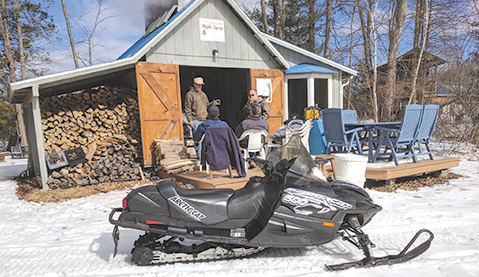On the west side of town down a meandering dirt road is a maple sugaring operation run since 2000 by two men. Several decades ago, Bob Howe, a retired aerospace engineer, and Scott Miller, a retired business owner of a dairy product distributer company, went to see a maple sugar demonstration at Northwest Park. They came home with five aluminum buckets, but that was just the beginning. Their wheels were turning. Take a moment to think back to the scene from Apollo 13 where Tom Hanks and Kevin Bacon can only return to earth safely if they put their heads together and transform everyday things into a space craft. Hanks and Bacon have nothing on our team of Howe and Miller, who launched their maple sugaring operation with an evaporator crafted out of a couple of lasagna pans, a 50-gallon drum and a smokestack. Over the years they have tweaked their operation, made upgrades and ultimately purchased an evaporator. They built a sugar shack to house it, but that was long after they had operated with their own jury-rigged version. Their sugar shack takes advantage of the best of New England’s late winter days with a view of beautiful wetlands and a sunny southern exposure. And on that spot, the two men, their families and various other friends have pitched in to stoke the fire, watch the sap or taste the syrup. The first year they produced five gallons of syrup, but more recently they have peaked at 83 gallons. This data is all proudly displayed in the sugar shack on a sugaring history board, a nod to both the engineer and the milkman.

So these February days the men have set the sugaring wheels in motion. Year-round tree huggers, they have been scouting out maple trees and getting their drills and taps ready. They have tapped the sugar maples in their yards and are hoping for cold nights and warm days which really help the sap flow. In true engineer fashion, one of the team has a test tree steps from his driveway. This tree provides a “sap report” each day by its sap production. The output or lack thereof indicates if the sap is really running and if the work force needs to be mobilized to empty the buckets recalling Mickey Mouse with his bucket brigade in Fantasia.
Each season they start fresh by drilling new holes in the trees, and they are now using a more slender tap with a 5/16th inch drill to make less of an impact on the trees. Then it is on to sap collection and emptying the buckets into a holding tank, which is gravity fed, into the sugar shack. They fire up the evaporator which provides the sap with the maximum surface area. It madly burbles away while they add more wood every seven minutes to keep the sap boiling. They even resorted to using a timer as watching over the sap lends itself to deep conversations and daydreams, and the sap waits for no one. It needs to be watched to make sure it doesn’t burn or boil over or to be sure it does not cool off too much.
After about eight hours of rapid boiling with steam escaping from the cupola, most of the water evaporates. For every 40 gallons of sap, they are usually able to produce a gallon of syrup. When they filter the syrup, they are left with a by-product called sugar sand which some folks ferment to make alcoholic beverages, but the Howe/Miller team does not go down that route. The entire process is labor intensive, but these men love the great outdoors and problem solving and are rewarded with syrup which trickles down the side of a short stack on a Sunday morning. It’s pretty hard to top that, although the window for maple sugaring is a brief one. Soon, the maples will bud out and the peepers will start to call, and it will be time to trade the evaporator and buckets for a fishing line or a hoe.